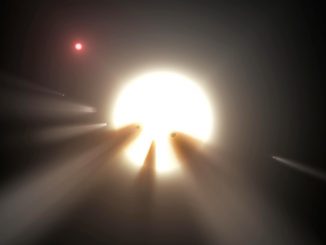
Astronomers have found a third exoplanet orbiting a binary star system 3,340 light years from Earth, the first, and so far only, multi-planet circumbinary solar system discovered to date. It also is the first binary system to be “filled in” with the maximum number of planets that can be sustained in stable orbits by two such stars.
The suns at the heart of the Kepler-47 system orbit each other every 7.45 days. One is similar to the Sun while the other has about one-third the mass of Earth’s star. All three planets were discovered by the Kepler Space Telescope, which charted the subtle dimming of starlight as the planets passed in front of their host suns as viewed from Earth.
The innermost planet, Kepler-47b, is 3.1 times Earth’s size and completes one orbit every 49 days. The outermost planet, Kepler-47c, is 4.7 times larger than Earth and takes 303 days to complete one trip around the binary. The recently confirmed Kepler-47d is sandwiched between the other two and is the largest of the trio, seven times larger than Earth, taking 187 days to complete one orbit.
The entire binary solar system would fit inside Earth’s orbit around the Sun.
“We saw a hint of a third planet back in 2012, but with only one transit we needed more data to be sure,” Jerome Orosz, an astronomer at San Diego State University and lead author of a paper detailing the discovery. “With an additional transit, the planet’s orbital period could be determined, and we were then able to uncover more transits that were hidden in the noise in the earlier data.”
Nader Haghighipour, an astronomer at the Institute for Astronomy at the University of Hawaii, said the discovery of Kepler-47d confirmed two predictions: that planets can form around binary stars in the same manner the form around single suns; and that such systems can support the maximum number of planets in dynamically allowable orbits.
Nine transiting circumplanetary systems have been discovered to date, but Kepler-47 is the only one hosting more than one planet.



